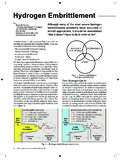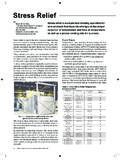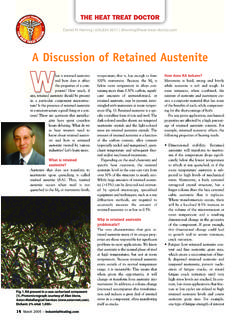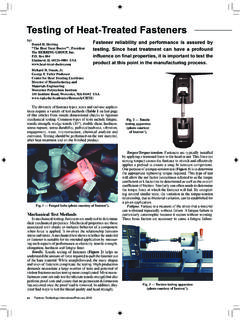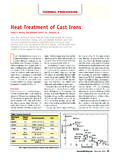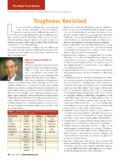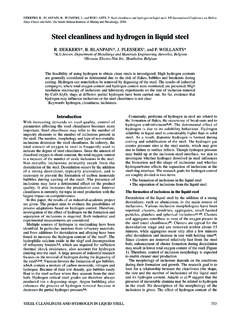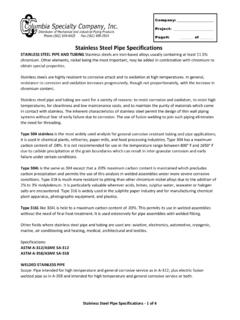Transcription of Steel Cleanliness: Inclusions in Steel S
1 TH rialH 18 August 2009 - cleanliness has become a topic of great interest to the heat treater given the reality that Steel is a global-sourced commodity. Often, the type and dis-tribution of Inclusions have a signifi cant infl uence on mechanical properties. It s time to review this subject so that we can continue to better understand the Steel we process. Let s learn more. The composition, size, number and distribution of Inclusions determine the cleanliness of Steel . Very large nonmetallic inclu-sions of any sort are undesirable, while very fi ne dispersions can be either helpful or harmful. Larger Inclusions are responsible, to a greater or lesser extent, for directional properties, notch sensitivity, creep and re-portedly poor fatigue properties.
2 There are a number of rating systems and methods to determine inclusion count, and these are commonly presented in terms of severity (Table 1 online only). Common test methods include ASTM E 45-05e2 (Standard Test Method for Determining the inclusion Content of Steel ) and ASTM E 2142-08 (Standard Test Methods for Rating and Classifying Inclusions in Steel Using the Scanning Electron Microscope).Where Do Inclusions Come From?The steelmaking process (tap, ladle treatment and continuous casting) is the source for most nonmetallic Inclusions (Fig. 1), although indigenous (natural) sources, alloy additions and exog-enous (foreign) sources such as refractory or slag also contribute. Most are formed because admixture dissolubility decreases during cooling and are Inclusions Classifi ed?
3 Nonmetallic Inclusions are typically divided into the following groups: oxides, sulfi des, silicates, nitrides and phosphides. Inclu-sions bonded with oxygen are further divided into free oxides, spi-nels (compound oxides in bi- and tri- confi gurations) and silicates (pure or admixed).Types of Inclusions Inclusions fall into the following general categories: CaO-SiO2-Al2O3 FexMn1-xO-SiO2-Al2O3 FexMn1-xO-SiO2-CryAl2-yO3 FexOy (oxides) FexOy (oxides) + Transition Metals (lanthanides, Ti, Zr, Hf, V, Nb, Ta) MgO-SiO2-Al2O3 MnO-SiO2-Al2O3 MnS (sulfi des) Se + TeTo f a c i l i t a t e i d e n t i fi cation, Inclusions can be grouped based on three predominate optical characteristics: color, refl ectivity and reaction to polarized light (Table 2 online only).
4 Some inclu-sions fall into multiple categories. Here s a brief overview of the more common types of Inclusions :1. Alumina (Al2O3) is found in Steel in which aluminum has been added typically to control grain size or as a deoxidant. It can also be carried into steels from refractories in which case the Inclusions tend to be large and isolated. Optically, they appear as stringers, often with comet tails due to Aluminum sulfi de (Al2S3) is found in steels deoxidized with excess amounts of aluminum. These Inclusions are less soluble in Steel than manganese sulfi de and separate out earlier, form-ing large Chromite ( or ) is a spinel found in chromium steels or where ferrochromium has been added. Par-ticles are angular with a tendency to Chromium sulfi de (Cr2S3) is generally found in 1% and higher chromium steels.
5 In cast Steel they are globular, triangular or rectangular in shape and often mistaken for iron sulfi de (FeS).5. Fayalite ( ) is found in steels deoxidized with silicon. Two types are typical translucent and Graphite (C) is one of the principal elements in cast irons. 7. I r o n a lu m i n ate (Fe ) is a spinel found in steels deoxi-ttgthSSSteel cleanliness : Inclusions in SteelDaniel H. Herring | 630-834-3017 | Heat Treat DoctorFig. 1. Typical nonmetallic inclusionTH rialH dized with aluminum. Inclusions are found in cast steels singly and as laths or tabular crystals and are often observed with iron oxide (FeO) Iron nitride (Fe2N, Fe4N) is found in steels high in nitrogen (or in nitrided steels), and it s not normally classifi ed as a non-metallic inclusion .
6 Occurs as needles or bands that tend to fol-low the grain Iron oxide is generally found with manganese oxide. In cast materials Inclusions are globular, dendritic or angular in shape. Often mistaken for MnS (silver nitrate whitens MnS but leaves FeO unattacked).10. Iron sulfi de is found in low-manganese and high-sulfur Steel (Mn:S ratio<4). Can cause hot-shortness due to its low melt-ing point 988 C (1810 F). In cast material it is often observed at grain Manganese-iron-silicates are a complex inclusion type in which the silicates can be either acidic (large amounts of sili-con with some manganese going into solution) or basic (aver-age amounts of silicon and average-to-low amounts of manga-nese).12. Manganese sulfi de is the most common type of inclusion en-countered.
7 According to analysis based on the Steel ingots containing sulfur, the morphology is typically clas-sifi ed into three types:a. Type I are silicon-killed steels (or steels incompletely killed with aluminum, zirconium or titanium). MnS are globular with a wide range of sizes and often duplex with Type II are aluminum-killed steels with no excess of alu-minum having a dendritic structure (called grain-boundary sulfi de because MnS is forms on grain boundaries).c. Type III are found if excessive amounts of aluminum are present or if magnesium is used as a deoxidant. They are angular and always form as monophase Inclusions . Massive spherical Inclusions are found in high-sulfur, free-ma-chining steels. In this type of Steel , low silicon contents give Inclusions with the best length-to-width ratio for optimum machinability.
8 Type I and Type III are preferred since Type II is associated with low Manganese-aluminum-silicate ( ) forms in the presence of manganese oxide, aluminum oxide and silica. Large Inclusions have six sides, and smaller Inclusions are globular in Titanium carbonitride (Ti(CN)) is found in high carbon and alloy tool steels and in plain-carbon steels that have been killed with ferro-titanium. Particles are well-defi ned and an-gular and are often mistaken for titanium sulfi Titanium oxide is found in steels deoxidized with titanium or ferro-titanium. Four oxides of titanium are commonly found (Ti2O3, TiO, , Ti2O3). TiO appears as cubic crystals often found near Ti2O3 Inclusions that are globular in shape and often contain iron.
9 TiO is often confused with Zirconium nitride (ZrN) is found in Steel that has been de-oxidized with zirconium. In cast materials, Inclusions can be square, rectangular, triangular, trapezoidal or octagonal. Low zirconium content produces softer Inclusions . May be found within an oxide Zirconium sulfi de (ZnS2) is found in steels deoxidized with zir-conium. Inclusions with less zirconium tend to deform more easily. In cast material, the Inclusions are Electron Microscopy (SEM) MethodsSince modern steels have fewer and fi ner nonmetallic Inclusions , the use of scanning electron microscopy (SEM) has become popu-lar for those who have this tool available. Individual Inclusions of-ten consist of more than one type, such as sulfi des and silicates, so energy dispersive spectroscopy (EDS) analysis is a useful tool.
10 EDS offers both point analysis and X-ray maps to distinguish among types of Inclusions directly, not just by inference from shape. ASTM E 2142 defi nes three methods of inclusion analysis. Method 1 is analogous to E45 or E 1122 for automatic image anal-ysis. Method 2 uses EDS to sort the Inclusions into traditional composition classifi cations as defi ned in E 45. Method 3 allows customization into classes as necessary, and it is this method that is particularly useful for duplex or complex Inclusions . Although the standard is written for Inclusions in Steel , the method could be extended to other discrete second phases or ControlAn example of manipulation of Inclusions is the modifi cation of composition and morphology of oxides and sulfi des in calci-um-killed Steel .
